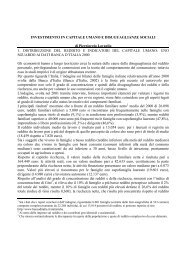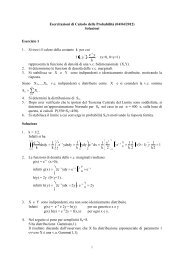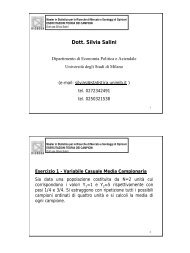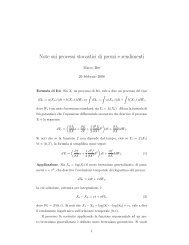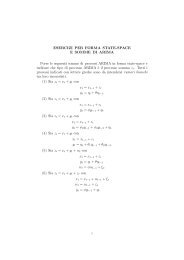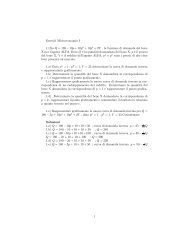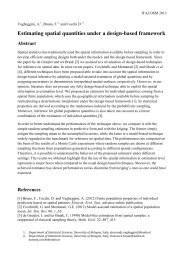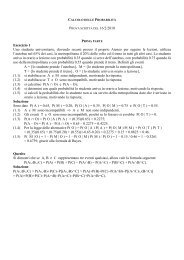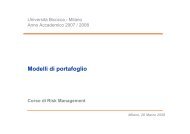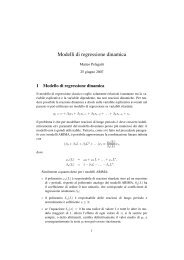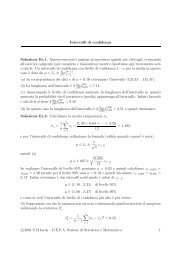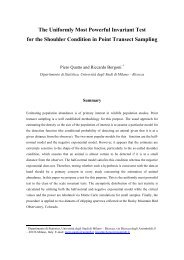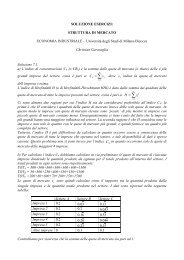A Method to Estimate the Human Capital from Sample Surveys on ...
A Method to Estimate the Human Capital from Sample Surveys on ...
A Method to Estimate the Human Capital from Sample Surveys on ...
You also want an ePaper? Increase the reach of your titles
YUMPU automatically turns print PDFs into web optimized ePapers that Google loves.
where F =(y 14 , Ψ) and v 1 ′ =(v 11 , v 12 )′ is <str<strong>on</strong>g>the</str<strong>on</strong>g> firsteigenvec<str<strong>on</strong>g>to</str<strong>on</strong>g>r of F′F, HĈ is <str<strong>on</strong>g>the</str<strong>on</strong>g> first principal comp<strong>on</strong>en<str<strong>on</strong>g>to</str<strong>on</strong>g>f F after its standardizati<strong>on</strong> <str<strong>on</strong>g>to</str<strong>on</strong>g> unit variance(Var(HĈ)=1), v 11 c<strong>on</strong>tains <str<strong>on</strong>g>the</str<strong>on</strong>g> element of <str<strong>on</strong>g>the</str<strong>on</strong>g> firsteigenvec<str<strong>on</strong>g>to</str<strong>on</strong>g>r c<strong>on</strong>nected with y 14 , v 12 is <str<strong>on</strong>g>the</str<strong>on</strong>g> sub-vec<str<strong>on</strong>g>to</str<strong>on</strong>g>r ofv 1 c<strong>on</strong>nected with Ψ.First of all, <str<strong>on</strong>g>the</str<strong>on</strong>g> estimate HĈ of HC does not take in<str<strong>on</strong>g>to</str<strong>on</strong>g>account <str<strong>on</strong>g>the</str<strong>on</strong>g> actual effects of <str<strong>on</strong>g>the</str<strong>on</strong>g> investment in HC <strong>on</strong><str<strong>on</strong>g>the</str<strong>on</strong>g> income and wealth of <str<strong>on</strong>g>the</str<strong>on</strong>g> households.Sec<strong>on</strong>dly, also <str<strong>on</strong>g>from</str<strong>on</strong>g> <str<strong>on</strong>g>the</str<strong>on</strong>g> statistical point of view, <str<strong>on</strong>g>the</str<strong>on</strong>g>reare some general critique about <str<strong>on</strong>g>the</str<strong>on</strong>g> soluti<strong>on</strong>s obtainedby means of PLS (Garthwaite 1994).In this case, in particular, every soluti<strong>on</strong> that can beobtained in (3) starting <str<strong>on</strong>g>from</str<strong>on</strong>g> (7) is logicallyinc<strong>on</strong>sistent. In effect, substituting HC^ obtained by(7) in (4) we obtain:and <str<strong>on</strong>g>from</str<strong>on</strong>g> (7) we have:Q y14y 17 = HĈ k 2 # + u 17 (8)k # 2 = HC^′ Qy y17 =(y 14 v 11 + Ψ v 12 )′ 14Q y14y17=v 12 ′ Ψ ′ Qy y 17 (9)14#<str<strong>on</strong>g>from</str<strong>on</strong>g> which k 2 cannot c<strong>on</strong>sider <str<strong>on</strong>g>the</str<strong>on</strong>g> whole HCc<strong>on</strong>tributi<strong>on</strong> <str<strong>on</strong>g>to</str<strong>on</strong>g> earned income y17 because, byQ y14definiti<strong>on</strong>, <str<strong>on</strong>g>the</str<strong>on</strong>g> indirect c<strong>on</strong>tributi<strong>on</strong> of Wealth <strong>on</strong>Income y 17 by means of HĈ is null.However, if we c<strong>on</strong>sider equati<strong>on</strong> (3) where <str<strong>on</strong>g>the</str<strong>on</strong>g>dependent variable is Income y 17 we have, substitutingHĈ obtained by (7):y 17 = [y 14 , y 14 , Ψ] ⎜ ⎜⎛10⎜⎝00 ⎞⎟ ⎛ k1⎞v11⎟⎜⎟v⎟ ⎝k2 ⎠12 ⎠+ u 17 (10)In (10) we observe <str<strong>on</strong>g>the</str<strong>on</strong>g> presence of collinearity betweenregressors, and if we join <str<strong>on</strong>g>the</str<strong>on</strong>g> parameters, we cannotdivide <str<strong>on</strong>g>the</str<strong>on</strong>g> direct c<strong>on</strong>tributi<strong>on</strong> of Invested Wealth <strong>on</strong>Income and <str<strong>on</strong>g>the</str<strong>on</strong>g> indirect c<strong>on</strong>tributi<strong>on</strong> of Wealth bymeans of HĈ. In effect,y 17 = y 14 [ k 1 + v 11 k 2 ] + Ψv 12 k 2 + u 17 (11)The Latent Variable Approach: a new proposalIt has been shown that <str<strong>on</strong>g>the</str<strong>on</strong>g> soluti<strong>on</strong>s obtained by meansof <str<strong>on</strong>g>the</str<strong>on</strong>g> Fac<str<strong>on</strong>g>to</str<strong>on</strong>g>r Model are not unique and that <str<strong>on</strong>g>the</str<strong>on</strong>g>soluti<strong>on</strong>s obtained by <str<strong>on</strong>g>the</str<strong>on</strong>g> PLS <str<strong>on</strong>g>Method</str<strong>on</strong>g> are not logicallyc<strong>on</strong>sistent (Lovaglio 2003). In order <str<strong>on</strong>g>to</str<strong>on</strong>g> overcome thisproblem, a soluti<strong>on</strong> can be found in <str<strong>on</strong>g>the</str<strong>on</strong>g> use of all <str<strong>on</strong>g>the</str<strong>on</strong>g>informati<strong>on</strong> embedded in <str<strong>on</strong>g>the</str<strong>on</strong>g> Path Analysis model (2)(3). In this way, <str<strong>on</strong>g>the</str<strong>on</strong>g> HC is not previously obtained inequati<strong>on</strong> (3) but, respecting <str<strong>on</strong>g>the</str<strong>on</strong>g> ec<strong>on</strong>omic relati<strong>on</strong>shipsis simultaneously obtained <str<strong>on</strong>g>from</str<strong>on</strong>g> reflective andformative indica<str<strong>on</strong>g>to</str<strong>on</strong>g>rs. In this perspective, observing <str<strong>on</strong>g>the</str<strong>on</strong>g>Path Analysis model (2) and (3), HC can be defined asa multidimensi<strong>on</strong>al c<strong>on</strong>struct approximated by <str<strong>on</strong>g>the</str<strong>on</strong>g>linear combinati<strong>on</strong> of its formative indica<str<strong>on</strong>g>to</str<strong>on</strong>g>rs (y 14 ,Ψ)that better fits <str<strong>on</strong>g>the</str<strong>on</strong>g> <strong>on</strong>ly reflective indica<str<strong>on</strong>g>to</str<strong>on</strong>g>rthat we can define as <str<strong>on</strong>g>the</str<strong>on</strong>g> earned income effect.Therefore we have <str<strong>on</strong>g>from</str<strong>on</strong>g> (2) :Premultiplying <str<strong>on</strong>g>the</str<strong>on</strong>g> equati<strong>on</strong> (13) by F and taking in<str<strong>on</strong>g>to</str<strong>on</strong>g>account (2) we obtain:yQ y14 17,Q y14y 17 = Fgk 2 +u 17 =F k 3 +u 17 where k 3 = gk 2 (12)In (12) we obtain k * 3by means of an ordinary LeastSquares Regressi<strong>on</strong> of Q y y17 <strong>on</strong> F. The k * 143vec<str<strong>on</strong>g>to</str<strong>on</strong>g>rc<strong>on</strong>tains <str<strong>on</strong>g>the</str<strong>on</strong>g> effects of <str<strong>on</strong>g>the</str<strong>on</strong>g> formative indica<str<strong>on</strong>g>to</str<strong>on</strong>g>rs F <strong>on</strong>earned income yQ y14 17:k * -13= g k 2 = S F F′ Qy y17 where S F = F′F (13)14F k * 3= F g k 2 = HC k 2 (14)Remembering that Var(HC) = S HC =1 we reach:* *2k3′SF k3= k2 S HC k 2 = k 2(15)From (15) we obtain k 2 * , <str<strong>on</strong>g>the</str<strong>on</strong>g> effect of HC <strong>on</strong> incomenet of wealth yQ y14 17:k 2 * = [(y 17 ′ Q y14F SF -1 F′ Q y14y17] 1/2 == [y 17 ′ Qy PF y14Q y14 17] 1/2 (16)where P F =F(F′ F) -1 F′.Therefore, <str<strong>on</strong>g>from</str<strong>on</strong>g> (13) and (16), we obtain g*, <str<strong>on</strong>g>the</str<strong>on</strong>g> effec<str<strong>on</strong>g>to</str<strong>on</strong>g>f <str<strong>on</strong>g>the</str<strong>on</strong>g> formative indica<str<strong>on</strong>g>to</str<strong>on</strong>g>rs F <strong>on</strong> HC:g*= k * / k =3*2= [y 17 ′ Q y14PF Q y14y 17 ] -1/2 S -1 F F′ Q y14y17 (17)At this point <str<strong>on</strong>g>from</str<strong>on</strong>g> (2) and (17) we obtain <str<strong>on</strong>g>the</str<strong>on</strong>g> estimati<strong>on</strong>of HC scores (HC*) :HC* = F g* (18)The Latent Variable Approach: mixed indica<str<strong>on</strong>g>to</str<strong>on</strong>g>rsIn our case, some of <str<strong>on</strong>g>the</str<strong>on</strong>g> formative indica<str<strong>on</strong>g>to</str<strong>on</strong>g>rs arecategorical.Therefore we partiti<strong>on</strong> <str<strong>on</strong>g>the</str<strong>on</strong>g> vec<str<strong>on</strong>g>to</str<strong>on</strong>g>r of formativeindica<str<strong>on</strong>g>to</str<strong>on</strong>g>rs in<str<strong>on</strong>g>to</str<strong>on</strong>g> quantitative (c<strong>on</strong>tained in <str<strong>on</strong>g>the</str<strong>on</strong>g> column ofmatrix F q ) and categorical indica<str<strong>on</strong>g>to</str<strong>on</strong>g>rs F c in order <str<strong>on</strong>g>to</str<strong>on</strong>g>obtain c<strong>on</strong>sistent soluti<strong>on</strong>s with <str<strong>on</strong>g>the</str<strong>on</strong>g> quantitative case.We express <str<strong>on</strong>g>the</str<strong>on</strong>g> equati<strong>on</strong> (2) in <str<strong>on</strong>g>the</str<strong>on</strong>g> following way:HC = F c g c + F q g q + u 16 , (F c = x 3 , x 4 , x 5 , x 7 ) (19)where F = (F c ,F q ), g = (g c ,g q )



